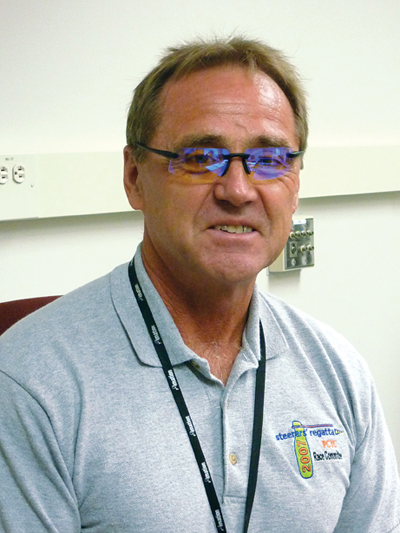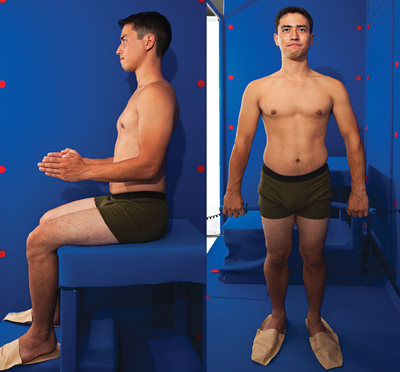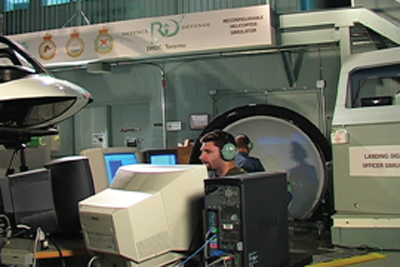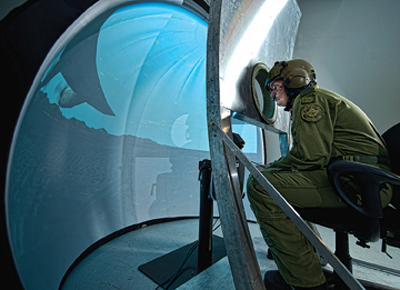
Features
Keeping Canada Competitive
In an obscure corner of what was once Canadian Forces Base Toronto (i.e., Downsview airport) in north-central Toronto, leading-edge scientific research and testing has been conducted for 55 years
November 30, 2009 By Mike Minnich
In an obscure corner of what was once Canadian Forces Base Toronto (i.e., Downsview airport) in north-central Toronto, leading-edge scientific research and testing has been conducted for 55 years, much of it aviation- and aerospace-oriented. Housed in a sprawling complex – built in the early 1950s and expanded several times since then – whose labyrinth corridors connect a spectrum of technological research projects, the Toronto branch of Defence Research and Development Canada (DRDC) combines a mix of civilian and military expertise. It works on everything from deep-sea diving technique to designing a better G-suit for high-altitude fighter pilots.
 |
|
| 1|Glasses developed at the University of Toronto have light-yellow lenses and basically block the blue-green light spectrum; this suppresses the removal of melatonin that the brain normally undertakes when in daylight.
|
Known until April 2002 as The Defence & Civil Institute of Environmental Medicine – and, years before that, as the Defence Research Establishment Toronto – DRDC traces its heritage even further back, to the early days of the Second World War when, among other things, one of the first human centrifuges in the world was developed at a predecessor Toronto location by the famed Dr. W.R. Franks, subsequent inventor of the “anti-G suit,” that has saved countless fighter-pilot lives by helping counteract loss-of-consciousness onset during intense aerobatic manoeuvres.
Here’s a rundown of four projects that are especially interesting:
1. Aircrew fatigue countermeasures
Proper rest (and therefore alertness) is a vital requirement for pilots and other aircrew. In high-intensity military – and sometimes civilian – operations, however, that can be easier said than achieved, especially when the crew is operating far from their natural “body-clock” time zone. DRDC’s Michel Paul is a world-class specialist in fatigue countermeasures.
“I moved into aircrew fatigue countermeasures research in the mid-1990s, when the Canadian Forces were heavily involved in flying troops and equipment into the Former Yugoslavia, flying from CFB Trenton to an RAF base in England, and then on to Sarajevo,” he begins.
“Initially, there were 18 Canadian aircraft involved, with one landing in-theatre every four hours around the clock. The aircrew were trying to go to sleep upon arrival in England, where it was 2200 hours local…but their body clocks were only at 1500 hours, and they just weren’t able to get to sleep quickly, because the sleep-inducing melatonin hormone that our bodies always produce when it begins to get dark – and which leaves our bloodstream when it gets light at dawn, in what’s called the circadian rhythm – obviously wasn’t getting naturally produced as early as 1700 hours,” Paul explains.
Paul’s team measured aircrew performance in flight and also tracked actual crew sleep periods using wrist actigraphs (which detect even minute body movement, at 0.1-second intervals) and revealed serious fatigue-based performance issues, even though this data was taken somewhat later, when the flight intensity had slacked off to three flights per week. Subsequent lab tests in Toronto involved giving subjects either doses of melatonin or a generic sleep-inducing drug called Zopiclone, letting them sleep from 1700 hours to midnight, and then waking them up to do mental-acuity testing for the next seven hours. This proved that using melatonin effectively shifted the circadian rhythm forward, and allowed sound sleep earlier than the body would naturally “want” to do.
Reduced doses of melatonin were subsequently administered to operational air-transport aircrews, and the benefit was exactly the same as in the controlled lab environment. A few years later, with the advent of Canada’s military operation in Afghanistan, even rougher fatigue issues came to the fore.
“In 2003, I accompanied an incoming Hercules relief crew as they deployed via Airbus to Camp Mirage, our sustainment base in the Arab-Persian Gulf, and by the time I got there, I was experiencing the worst jet lag I’d ever seen in my life, having crossed nine time zones in less than 18 hours,” he reports. “At the time, the Air Force was having these newly arrived crews start flying missions up to Afghanistan within 36 hours, and they were still so jet-lagged that I knew that wasn’t a good idea.”
Subsequent testing that compared the sleep habits of the new crew to a Herc crew that had been in-theatre for more than a month showed that it would take at least a five-day acclimation period until the new crew was safe to fly. This policy was subsequently put into effect. Paul speculated that an alternative to this would be to start giving late-afternoon supplementary melatonin dosages four days before the aircrew left Canada, plus one en route and one at the first sleep period at Mirage, and that would pull members’ body clocks forward the nine time zones.
“This procedure hasn’t yet been approved, but our studies definitely proved the feasibility,” he says. However, the five-days-on-the-ground rule has proved frustrating for another category of aircrew at Mirage: those flying our new C-17 strategic transports.
“They only fly at night up to Afghanistan, for tactical considerations, so these aircrew can make good use of that jet-lag ‘circadian inversion’ that they arrive with. Their bodies already want to be awake during local nighttime, so that’s helpful. The problem would be if they go outside in the daylight at the base, since then their bodies would start adapting to the local-time-zone sleep cycle. I think I may have come across a solution with glasses developed at the University of Toronto that have light-yellow lenses and basically block the blue-green light spectrum,” he explains.
It’s been shown that blocking this spectrum to the eyes suppresses the removal of melatonin that the brain normally undertakes when in daylight. Because aircrew who need to sleep during daylight and be awake at night need to maintain their “jet-lag melatonin” during the day, these glasses may be the solution.
“I’m waiting for funding from the Air Force to undertake a study to examine this theory,” Paul sums up. “And I’m hopeful that will come through before the end of 2009.”
 |
|
| 2|The Pilot Anthropometric Screening System (PASS) works in conjunction with the digital-camera-based Body Sizing System (BOSS) to automatically take 12 different body-dimension measurements.
|
2. Helping pilot candidates PASS
Although rarely a major concern in civil aviation, pilot (and sometimes other aircrew) physical dimensions can be a life-or-death factor in many military aircraft. Considerations that need to be addressed virtually as soon as a pilot candidate walks through the recruiting-station door include: the need for legs long enough to fully deflect the rudder pedals, arms long enough to provide full “authority” on the control stick, an eye level that can easily read all the instruments and gauges and also handle outside-the-cockpit scanning, and seated back-to-knee length that will still allow successful ejection-seat use.
“One of the first elements of the aircrew-selection process is to ensure that the applicant doesn’t have any ‘show-stopper’ anthropometric situations,” defence scientist Pierre Meunier explains. “That’s nothing new, but back in the 1960s through most of the 1970s, they were assuming male applicants, and also just measuring four dimensions: overall standing height; seated buttock-to-knee length; seated knee height; and buttock-to-heel length while sitting flat on the floor with legs straight out. Also, the criteria assumed that every applicant needed to be able to fit into any and all of the aircraft in the fleet.”
Among other things, the advent of female pilot applicants and the realization that it was unnecessary, and unrealistic, to demand that every pilot fit into every cockpit (nowadays, “streaming” into one of three core areas of specialty – fast jets, multi-engine or rotary-wing – occurs pretty early in the pilot-training syllabus) led to the conclusion that more appropriate body-measuring criteria and technology were required.
“Between 2002 and 2006, my associates and I developed what is now known as the Pilot Anthropometric Screening System (PASS), which works in conjunction with the digital-camera-based Body Sizing System (BOSS) to automatically take 12 different body-dimension measurements, and then runs those dimensions through detailed pre-calculated software modules that reflect the cockpit demands of any aircraft type in the inventory.
“PASS will provide a ‘grade’ that’s colour-coded red, yellow, or green with respect to each of those 12 applicant dimensions vis-à-vis a vast number of very specific cockpit criteria,” he adds. “The bottom line is that both the Forces and the applicant can see exactly where there are any problem areas. Any red- or yellow-flagged areas can then be ‘drilled-down’ into to get detailed feedback as to why those assessments were made.”
Plans call for the PASS system currently at Toronto to be relocated to the airbase at Trenton, Ont. (where the CF Aircrew Selection Centre is located) in the near future, and, if funding develops, perhaps to establish two additional ones at the training bases at Moose Jaw, Sask., and Portage La Prairie, Man.
“These additional locations would allow authorities to ensure that pilot trainees remain certified for the training aircraft as time goes by and possibly their weight or other dimensions would change,” Meunier explains. “As things stand now, the Hawk advanced jet trainer and the Bell Jet Ranger helicopter trainer are the two aircraft types in our entire fleet that have the tightest cockpit-occupant dimensions.”
Meunier also notes that his team has been able to get the process of incorporating a new aircraft type into the PASS database – which involves measuring a great number of physical dimensions at the actual aircraft and also interviewing subject-matter experts at the appropriate squadrons to determine which pilot-size factors really matter and which don’t – down to less than three weeks from the first visit to the end of data input.
“PASS has allowed the CF to create solid, scientifically demonstrable anthropometric occupational requirements for the pilot trade, and we are now researching using the same system for things like assessing Leopard-II tank drivers, and possible other land-vehicle applications. This system has a very bright future,” he sums up.
 |
|
| 3|SimON can provide a virtual Sea King helicopter pilot for a simulator that trains landing signals officers.
|
3. Not-so-simple SimON
When it comes to training activity, human beings are busy and expensive, and the fewer you have to pull in to help train a given student on a simulator, the better.
Enter SimON (Simulated Operator for Networks), a DRDC-developed system that, in the words of its handout “…is an engineering representation of operators that integrates relevant human-science knowledge into a model using the Integrated Performance Modeling Environment [IPME – an earlier DRDC/Toronto project] for representing procedural knowledge and task execution.”
In plain English, that means that SimON is an artificial-intelligence system that bridges the engineering and human-sciences sides of virtual-reality simulation, with a special emphasis on representing human behaviour in a networked environment. Both speech-recognition and voice-synthesis capabilities are supported.
“Our primary implementation of SimON so far has been to provide a virtual Sea King helicopter pilot for a simulator that trains landing signals officers (LSOs) in how to communicate with that pilot to safely achieve a landing on the small flight deck of a navy destroyer or frigate,” Brad Cain, of DRDC/Toronto’s Human Systems Modeling Group, explains.
Being able to simulate that pilot and to have the simulation realistically interact with the live human LSO student means that the CF would not have to pull a real pilot off his other duties to participate in training the LSO in a classroom. Also, the simulator reduces the need for the LSO student to tie up time and resources aboard an actual warship at sea.
“SimON is really a framework for building models,” Cain goes on, “in which you can bring in other modules as required, to affect how the behaviours are represented. SimON isn’t necessarily about doing things right…it’s about trying to build models that do things the way people actually do them. We wanted to be sensitive to errors in the same way individuals are sensitive to errors – judgment errors, things like that – and eventually incorporate elements like emotional and motivational modules that could affect performance, such as simulating fatigue, fear, confusion and so forth.”
At this point, SimON is a “proof-of-concept” demonstration project, and development to date has been aimed at replicating a limited number of human players who can interact via a network with live individuals. If funding is forthcoming, future applications are envisioned for simulation-based acquisition, operational analysis, mission planning or rehearsal, and accident investigation in addition to training functions such as with the shipboard LSO.
“Military simulation is moving away from the large numbers of force-on-force, attrition-type models and instead there’s greater interest in models where individual decisions, behaviours and performance actually make a difference to the outcome of the problem that’s under study,” Cain observes. “That’s where we think SimON can make a real contribution.”
“However,” he adds with understated humor, “it’s still a big challenge, modelling people. They demonstrate non-linear behaviours even under similar circumstances.”
 |
|
| 4| The HOT (Hercules Observer Trainer) allows a headset-equipped trainee to sit at an actual Herc door and window, looking out at a circular concave screen onto which a digitally generated scene of sky and land is projected.
|
4. Hercs in a HOT war zone
Virtually every day, a four-engined CC-130 Hercules tactical transport flies north from an airfield in the Arab-Persian Gulf region and, several hours later, lands at Kandahar Airfield, Afghanistan, with personnel, supplies or other equipment for Canada’s combat task force there. On its subsequent outbound leg, troops on leave or at the end of their tour of duty constitute the primary cargo.
These Hercs are a vital element in sustaining Canada’s presence in “A-stan”…and that makes them targets that Taliban or al-Qaida forces would dearly love to shoot down. DRDC/Toronto has developed a trainer that helps make that less likely.
“When a CC-130 is flying in a threat zone, the two loadmasters in back typically serve as observers, looking out the bubble windows in the left and right paratroop doors and constantly scanning for any ground-to-air or air-to-air threats,” Tony Ghoman of DRDC’s Human Effectiveness Experimentation Centre explains. “In the past, training ‘loadies’ for this observer function was just done in a classroom by showing slides and/or videos of the threats – machine guns, anti-aircraft cannons, surface-to-air missiles, and so forth – in action, and teaching them what “threat call” terminology to use over the intercom to alert the pilots to its nature and direction.
“In 2006, the Air Force wrote a Statement of Operational Capability Deficiency that basically said this wasn’t good enough, and could somebody come up with a better system,” he goes on. “That request ended-up here at DRDC/Toronto about three years ago. Today, the result is HOT: the Hercules Observer Trainer.”
Reduced to its essentials, HOT allows a headset-equipped trainee to sit at an actual Herc door and window, looking out at a circular concave screen onto which a digitally generated scene of sky and land is projected. When a threat is spotted with the “Mark-I eyeball,” the loadmaster immediately assesses the threat and warns the pilot over the intercom. The remotely located instructor who plays the role of the pilot can climb, dive or bank the “aircraft” as well as deploy defensive countermeasures (chaff/flares), and these manoeuvres are reflected in the scene the HOT is presenting. Each scenario lasts between five and 10 minutes. For debriefing purposes, the speed and accuracy with which the observer spots and reports threats is also recorded.
“We designed HOT to work over a network, so the instructor acting as the pilot doesn’t have to be physically co-located with the trainee,” Ghoman notes. “Also, we can modify the program to reflect other aircraft types, although so far the emphasis has just been on the Hercules.”
Currently, there are three terrain/flight-path scenarios available: an approach to Kabul, Afghanistan; flying near Vancouver, B.C. (because of the upcoming 2010 Winter Olympics); and a generic over-water environment for search-and-rescue activity (where the observer, of course, is concerned with spotting a vessel or survivors, not a hostile threat). In the most hard-edged application (Afghanistan), the programmed threats are anti-aircraft guns, surface-to-air missiles, armed helicopters and various combinations thereof.
“The ground details have been mostly derived from satellite imagery, and currently our image quality is 1400×1050 resolution,” Ghoman notes. “We’re now working on upgrading the system to incorporate four projectors whose images would be interlinked to create a terrain image that’s three times sharper than we have now.”
The only existing HOT at the moment is located at CFB Trenton for use by the loadmaster training course there, and fine-tuning is still underway by the staff at DRDC/Toronto. However, the future might hold a much-expanded suite of applications.
“The Air Force is also now looking for an enhanced threat-training system that could represent all the different aircraft types in the fleet, and which would be physically installed at every Canadian airbase, then networked together to allow distributed training,” Ghoman says. “An enhanced modification of HOT is being considered for this requirement, and we hope to learn the decision about this in the coming months.”
Commercializing the knowledge
While the core reason for the activities of DRDC/Toronto is to support requirements of the Department of National Defence, it can’t do everything in house. It’s fully accepted that outside private-sector partners to help find those solutions – and subsequent licensing agreements with firms that want to commercialize the technology – are also necessary. And that’s where acting external relations manager Darren Menabney comes in.
“Almost all our projects are initiated in house by defence scientists here,” he begins. “When one progresses to a certain point, we look at it to see if there might be some commercial potential, and whether we should seek patents. Getting patents is expensive, especially outside Canada and the U.S., so we only pursue that for high-potential projects.”
DRDC retains the intellectual-property rights for any technology or product it licenses for further commercial development by a private company. Projects that are ripe for potential involvement by a private-sector or university partner are advertised in the federal government’s MERX online contracts-and-tenders site. All funds that DRDC earns through licensing agreements go back into its budget to support future R&D activity.
“We finalize three or four licensing agreements in a typical year,” Menabney estimates. “One of the more significant ones has been the STING G-suit, which is not only manufactured under licence by Mustang Survival Systems out in B.C. for the Canadian Forces, but sold to approved overseas customers, too. Currently, PASS is out on a public tender, and we’re looking for a company – or a consortium of firms – to invest with us to develop it further, and then that partner could similarly conclude a licensing agreement to market it to military and civilian customers.”
Menabney notes that DRDC itself routinely contracts for expertise in support of its own projects, with about $150 million a year going out to companies and universities.
“And it works the other way as well,” he says. “DRDC will accept contracts from outside organizations to undertake specialized research for them, if it’s something where we have the best capability, and if we are able to fit it into our workload. As an aside, we also regularly hire out our low-pressure chamber here to firms and colleges that need to offer high-altitude-flying indoctrination to their people.”
“In short, almost everything we do here ultimately involves disseminating technology into Canadian industry and academia,” he says. “And that helps make Canada a more competitive economic player, right around the world.”